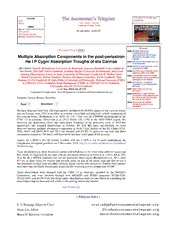
NASA Technical Reports Server (NTRS) 20150004438: Multiple Absorption Components in the Post-Periastron He I P Cygni Absorption Troughs of Eta Carinae PDF
Preview NASA Technical Reports Server (NTRS) 20150004438: Multiple Absorption Components in the Post-Periastron He I P Cygni Absorption Troughs of Eta Carinae
Outside This space for free for your GCN conference. IAUCs Post | Search | Policies Credential | Feeds | Email Other ATel on Twitter and Facebook 26 Jan 2015; 13:26 UT ATELstream ATel Community Site MacOS: Dashboard Widget Related [ Previous | Next | ADS ] 6685Multiple Absorption Components in the Multiple Absorption Components in the post-periastron post-periastron He I P Cygni Absorption Troughs of eta Carinae He I P Cygni Absorption Troughs of eta Carinae 6453eta Carinae Emerging from the X-ray Minimum 6448Eta Car's spectroscopic event ATel #6685; Noel D. Richardson (Universite de Montreal), Augusto Damineli (Universidade de compared to 2009 Sao Paulo), Ted Gull (NASA Goddard), Anthony Moffat (Universite de Montreal), Jose Groh 6408Eta Car's spectroscopic event begins to differ from 2009 (Geneva Observatory), Lucas St-Jean (Universite de Montreal), Frederick M. Walter (Stony 6380The stability of the He II 4686 Brook University), Mairan Teodoro (Western Michigan University; NASA Goddard), Tom line emission across periastron Madura (NASA Goddard), D. John Hillier (University of Pittsburgh), Micheal Corcoran (USRA passages in eta Carinae & CRESST; NASA Goddard), Kenji Hamaguchi (UMBC & CRESST; NASA Goddard), 6368eta Carinae -- Caught in Transition to the Photometric Christopher Russell (NASA Goddard) Minimum on 11 Nov 2014; 01:28 UT 6357Start of Eta Car's X-ray Credential Certification: Noel Richardson ([email protected]) Minimum 6336Detection of High Velocity Absorption Components in the Subjects: Optical, Binary, Variables He I lines of eta Carinae near the time of Periastron 6334Structured He II 4686A TTwweeeett 3 RReeccoommmmeenndd 7 emission in eta Car near periastron We have obtained more than 100 high spectral resolution (R~90,000) spectra of the massive binary star eta Carinae since 2012 in an effort to continue our orbital and long-term echelle monitoring of this extreme binary (Richardson et al. 2010, AJ, 139, 1534) with the CHIRON spectrograph on the CTIO 1.5 m telescope (Tokovinin et al. 2013, PASP, 125, 1336) in the 4550-7500A region. We increased our monitoring efforts and observation frequency as the periastron event of 2014 has approached, and resumed observations in October. We note that since mid-October, we have observed unusual multiple absorption components in the P Cygni troughs of the He I lines (4714, 5876, 6678, and 7065; 4921 and 5015 are blended with Fe II). In particular, we note that these components extend to -700 km/s, well beyond the terminal wind speed of the primary. Figure: He I 6678 + [Ni II] (black) overlaid with He I 5876 + Na D (red), highlighting the complicated absorption profile(s) on 3 November 2014: http://www.astro.umontreal.ca/~richardson /HeIrecent.png These absorptions are likely related to clumps and turbulence in the wind-wind collision region and bow shock, as suggested by the high-velocity absorption observed by Groh et al. (2010, A&A, 519, 9) in the He I 10830A transition and our pre-periastron observations (Richardson et al. 2014, ATel #6336). In these cases, we suspect that we look along an arm of the shock cone and that we see a fast absorption change from the other collision region shortly after periastron. Further, high spectral resolution data are highly encouraged, especially for resolving powers greater than 50,000. These observations were obtained with the CTIO 1.5 m telescope, operated by the SMARTS Consortium, and were obtained through both SMARTS and NOAO programs 2012A-0216, 2012B-0194, and 2013b-0328. We thank Emily MacPherson (Yale) for her efforts in scheduling the observations that we have and will obtain in the coming weeks and months. Line Profile plot [ Telegram Index ] R. E. Rutledge, Editor-in-Chief Derek Fox, Editor Mansi M. Kasliwal, Co-Editor
